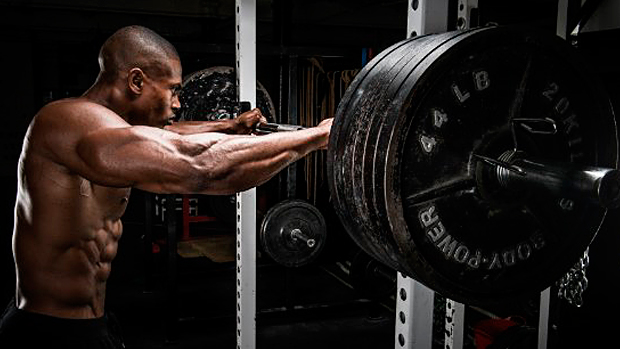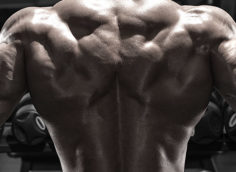Pop quiz, hotshot. On a max-out Friday type of day, a weightlifter steps up to a bar loaded with his personal record. He strains to clean the bar to his chest but misses the lift. The bar dumps to the platform with a thud. Why the hell did he miss it?
- A. The bar stayed away from his body on the first pull.
- B. He didn't finish his extension during the second pull.
- C. It was too heavy.
Most weightlifters want to answer with A or B, or some variation. I'm as guilty of that as anyone. Misses are often followed with shouts of "finish your pull," "faster hands," or some technical cue. Half the time this jibber jabber after a miss is right, but on many occasions a simpler, more honest answer is what's required:
"That was too much weight. You need to get stronger"
In Olympic lifting there's one type of strength that matters more than anything else. It'll make the pull off the ground faster and make maintaining positions easier. Plus, it'll make you feel like a rocket is up your ass as you come out of the bottom of the lift. It's squatting strength. And if you want to lift more weight you need to squat more often and to squat more weight. The normal training week featuring a single "squat day" just isn't going to cut it. I should be clear, the primary part of your program should consist of the competition movements or a variation – probably 60% or more of your total reps – but the remainder of the program will be a lot of squats, with just a small portion dedicated to pulls or some sort of pressing.
A certain level of technical competence is of course required for the "squat more, lift more" approach to be effective. I usually see this when my lifters have been in a few competitions, but in general it occurs after an athlete has been in the gym for a year or more. We have to remember that lifting is a skill and that skill has to be learned well for strength to carryover to the platform.
Olympic Lift Ratios
The squat is so important that many coaches have established exact correlations between your squat – both front and back – and the competition lifts. While there are different numbers that different coaches live by, the tried and nearly always true Olympic lift ratios in my gym are as follows:
- Front Squat = 85% of Back Squat Max
- Clean and Jerk = 85% of Front Squat Max (or about what you can front squat for 3 reps)
- Snatch = 85% of your Clean and Jerk Max
Don't believe me? Here are the numbers for me and a couple of my athletes:
| Junior (16 y/o 56k) | Me (32 y/o 85k) | Senior (23 y/o 94k) | |
|---|---|---|---|
| Back Squat | 130k | 220k | 210k |
| Front Squat | 112k (86% of back squat) | 187k (84% of back squat) | 175k (83% of back squat) |
| C&J | 96k (85% of front squat) | 160k (85.5% of front squat) | 155k (88% of front squat) |
| Snatch | 81k (84% of C&J) | 135k (84% of C&J) | 122k (79% of C&J) |
| Lifting | 2 years | 15 years | 8 months |
You might have noticed a couple of things with these ratios:
- The longer you lift, the more accurate these numbers will be. I've got a beast that's only been lifting for eight months, and his numbers are the furthest off the norms. That's probably a reflection of experience.
- Although you might think bigger lifters are more likely to have monstrous clean and jerks and lesser snatch numbers, smaller lifters are in fact more likely to have a greater disparity between clean and jerk and the snatch. If you need more proof of this concept, a recent analysis of the data from Olympic games showed the average of every athlete's snatch relative to their clean and jerk. That range was from 80 percent to 85 percent across all weight classes.
Testing My Point
Prior to my last cycle I was front squatting in the neighborhood of 155kg and back squatting 190k. I was struggling to make clean and jerks above 145kg. While I'd been lifting for 15 years, I was hoping that I could just clean up my technique and start hitting bigger numbers. In my gut though, I knew the inconvenient truth, which was that I just needed to get stronger. If my squat went up, then my lifts were going to increase. Sure enough, when my front squat went to 187k and back squat went to 220k, I started nailing anything and everything above 160k in the clean and jerk (with a PR clean of 165k). My snatch also moved from 123k to 135k. After 15 years, this was no small feat.
What If You Want to Squat More Weight?
What if you're a guy like me and you have the same epiphany that your squat strength is the limiting factor to your lifts? Then what? There are a bunch of programs out there that work. Smolov and Hatch come to mind, but both of those require serious investments in time. I didn't have the time or the desire to go through a squat cycle that involved just squatting for hours on end, so I found something much simpler.
What you need to do is squat at the start of every Olympic lifting training session. Rather than starting with the clean or snatch, spend time under the bar and in the rack to begin each session. After all, the squat makes the other lifts go. When the squats are finished, then proceed with your weightlifting session just as normal. If the day calls for 85% snatches, hit 'em after you squat. If the day calls for max clean and jerks, do 'em after you squat. Here's a sample of what squatting first might look like each week. It's also what I did last cycle to put 30k on my back squat and 30k on my front squat.
| Week 1 | Exercise | Sets/Reps | Intensity |
|---|---|---|---|
| Monday | Back Squat | 3 x 10 | 70% |
| Wednesday | Front Squat | 3 x 5 | 80% |
| Friday | Back Squat | 3 x 10 | 70% |
Do your squats first and then do whatever you need on your other lifts.
| Week 2 | Exercise | Sets/Reps | Intensity |
|---|---|---|---|
| Monday | Back Squat | 3 x 10 | 75% |
| Wednesday | Front Squat | 3 x 5 | 85% |
| Friday | Back Squat | 3 x 10 | 75% |
Do your squats first and then do whatever you need on your other lifts.
| Week 3 | Exercise | Sets/Reps | Intensity |
|---|---|---|---|
| Monday | Back Squat | 3 x 10 | 80% |
| Wednesday | Front Squat | 3 x 5 | 85% |
| Friday | Back Squat | 3 x 10 | 80% |
This is when stuff starts to get real. No relative intensity chart tells you to do 80% for sets of 10 in the squat, but try it, and if you can't hit 80%, try to get as close as possible. After the squats, do your snatches and clean and jerks.
| Week 4 | Exercise | Sets/Reps | Intensity |
|---|---|---|---|
| Monday | Back Squat | 3 x 10 | 70% |
| Wednesday | Front Squat | 3 x 5 | 75% |
| Friday | Back Squat | WU to a 10RM | X |
Work up to a 10RM on the third day. Have some spotters around just in case, but I bet you'll be surprised you hit what you do.
| Week 5 | Exercise | Sets/Reps | Intensity |
|---|---|---|---|
| Monday | Back Squat | 3 x 5 | 80% |
| Wednesday | Front Squat | 7 x 2 | 85% |
| Friday | Back Squat | 3 x 5 | 80% |
Then snatch and CJ your face off.
| Week 6 | Exercise | Sets/Reps | Intensity |
|---|---|---|---|
| Monday | Back Squat | 3 x 5 | 85% |
| Wednesday | Front Squat | 7 x 2 | 90% |
| Friday | Back Squat | 3 x 5 | 82% |
After squats, lift some heavy weight in everything else.
| Week 7 | Exercise | Sets/Reps | Intensity |
|---|---|---|---|
| Monday | Back Squat | 3 x 3 | 90% |
| Wednesday | Front Squat | 7 x 2 | 92% |
| Friday | Back Squat | 3 x 5 | 85% |
Like I said before, after squats, lift some more weight.
| Week 8 | Exercise | Sets/Reps | Intensity |
|---|---|---|---|
| Monday | Back Squat | 3 x 2 | 92-100% |
| Wednesday | Front Squat | 7 x 2 | 95% |
| Friday | Back Squat | 3 x 5 | 90% |
In the final week you should hit personal records of an additional 2 reps in the back squat and possibly the front squat. Your second squat day should see you hit a 5-rep PR in the back squat. By either projecting maxes based off these numbers or hitting actual maxes in week 9 or 10, your squat will go up. More importantly your other lifts will go up, too.





